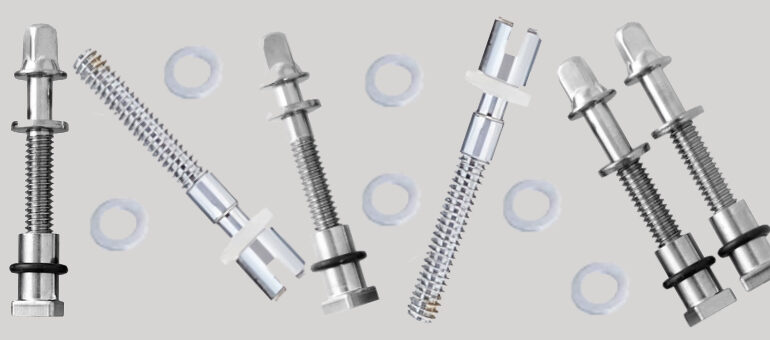The Most Common Uses of Drum Tension

Strong 8k brings an ultra-HD IPTV experience to your living room and your pocket.
Drum tension is a crucial aspect of drumming that impacts the instrument's sound, playability, and longevity. By adjusting the tightness of the drumhead via the drum lugs, drummers can achieve a wide array of sonic textures and characteristics.
In this comprehensive guide, we'll delve into the most common uses of Drum Tension and how it influences various facets of drumming. Whether you're a beginner or an experienced drummer, understanding drum tension will enhance your ability to produce the desired sound and improve your overall drumming experience.
1. The Basics of Drum Tension: Before diving into the specific uses, it's important to grasp the basics of drum tension. Drum tension refers to the tightness of the drumhead, which is controlled by adjusting the tension rods situated around the drum's perimeter. These rods are screwed into the drum's lugs and can be tightened or loosened to increase or decrease the tension on the drumhead.
Pitch Adjustment
One of the primary uses of drum tension is pitch adjustment. The pitch of a drum is determined by the tension of the drumhead: tighter tension results in a higher pitch, while looser tension results in a lower pitch. This principle applies to all drums, including snare drums, toms, and bass drums. By fine-tuning the tension, drummers can achieve the exact pitch they desire, which is essential for creating a harmonious and cohesive sound in a musical ensemble.
Harmonic Control
In addition to affecting pitch, drum tension also influences the harmonics and overtones produced by the drum. Proper tension helps control these harmonics, leading to a cleaner and more defined sound. When the drumhead is too loose, it may produce unwanted overtones, resulting in a muddled or chaotic sound. Conversely, excessively tight drumheads can choke the drum, reducing its resonance and overall musicality. Finding the right balance is key to achieving a well-rounded and pleasing drum sound.
2. Sound Character: The character of a drum's sound is largely dictated by its tension. Different tensions can produce a wide range of tonal qualities, making tension adjustments a powerful tool for drummers seeking to refine their sound.
Resonance and Sustain
One of the most noticeable effects of drum tension is on resonance and sustain. Higher tension typically increases both resonance and sustain, allowing the drum to ring out more clearly and for a longer duration. This can be particularly desirable in genres like jazz and orchestral music, where a more resonant drum sound is often preferred. On the other hand, lower tension tends to produce a shorter, punchier sound with less sustain, which can be ideal for genres like rock and hip-hop, where a more focused and immediate sound is desired.
Attack and Tone
Drum tension also impacts the attack and tone quality of the drum. Tighter heads generally produce a sharper, more articulate attack with a brighter tone. This can be advantageous in fast-paced music where clarity and precision are paramount. Conversely, looser heads yield a warmer, more mellow sound with a softer attack, which can be suitable for slower, more relaxed musical styles. By experimenting with different tensions, drummers can discover the specific attack and tone that best complements their playing style and musical context.
3. Playability: Drum tension significantly influences the playability of the instrument, affecting everything from stick response to overall feel.
Rebound and Feel
The tension of the drumhead directly affects the rebound of the drumstick and the overall feel of the drum. Tighter drumheads provide more rebound, making it easier for drummers to execute fast and intricate patterns with less effort. This increased rebound can enhance control and precision, particularly in genres that demand technical proficiency. On the other hand, looser drumheads offer less rebound, which can be beneficial for drummers who prefer a more relaxed and laid-back playing style. Adjusting the tension to match personal preference and playing technique is essential for achieving optimal playability.
Consistency
Consistency in tension across the drumhead is crucial for maintaining an even playing surface and predictable stick response. Uneven tension can result in "dead spots" or areas on the drumhead that produce inconsistent sounds, which can be frustrating and hinder performance. Ensuring that the tension is evenly distributed across all tension rods helps create a uniform playing surface, allowing drummers to achieve a consistent and reliable sound every time they play.
4. Genre and Style Suitability
Different music genres often require specific drum tensions to achieve their characteristic sound. Understanding how to adjust tension to suit various styles is a valuable skill for any drummer.
Jazz
In jazz, drummers often utilize higher tension for a brighter, more resonant sound. The increased resonance and sustain provided by tighter heads help the drums blend seamlessly with other acoustic instruments and contribute to the overall musical texture. Additionally, the enhanced rebound from tighter drumheads facilitates the quick and intricate drumming patterns commonly found in jazz.
Rock
Rock music typically demands a balanced tone with both attack and resonance. Medium tension is often preferred in this genre, as it provides a versatile sound that can cut through the mix without overpowering other instruments. The balanced attack and sustain of medium tension drumheads make them well-suited for the dynamic and powerful drumming required in rock music.
Funk and Hip-Hop
Funk and hip-hop genres sometimes employ lower tension for a deeper, punchier sound. The shorter sustain and warmer tone produced by looser drumheads can complement the groove-oriented nature of these styles. Additionally, the reduced rebound of looser heads can facilitate the relaxed and rhythmic drumming patterns characteristic of funk and hip-hop.
5. Maintenance and Longevity
Proper drum tension not only enhances sound and playability but also contributes to the maintenance and longevity of the drum.
Head Durability
Maintaining appropriate tension can extend the life of the drumhead by distributing the stress evenly and preventing premature wear or damage. Overly tight drumheads can place excessive strain on the material, leading to cracks or tears, while overly loose heads can cause the drumhead to sag and lose its shape. Regularly checking and adjusting tension ensures that the drumhead remains in good condition, providing consistent performance over time.
Hardware Preservation
In addition to protecting the drumhead, proper tension helps preserve the drum's hardware. Excessive tension can strain the lugs and tension rods, potentially leading to stripped threads or broken components. Conversely, insufficient tension can cause the lugs to loosen and rattle during play. By maintaining balanced and appropriate tension, drummers can protect their drum's hardware and ensure reliable operation.
6. Recording and Live Performance
Drum tension plays a vital role in both recording and live performance settings, affecting how the drum sounds through microphones and how consistent the sound remains across different contexts.
Mic Responsiveness
Adjusting drum tension can optimize the drum's sound for microphone pickup during recording or live performances. Higher tension can enhance the drum's clarity and articulation, making it easier for microphones to capture the nuances of the performance. Conversely, lower tension can provide a fuller, more rounded sound that can be beneficial in certain recording situations. By fine-tuning tension for specific recording or performance scenarios, drummers can achieve the best possible audio quality.
Sound Consistency
Maintaining consistent tension is crucial for ensuring a reliable and reproducible sound across different performances and recording sessions. Inconsistent tension can lead to variations in pitch, tone, and resonance, which can be problematic in both live and studio environments. By regularly checking and adjusting tension, drummers can ensure that their drum sound remains consistent and dependable, regardless of the setting.
Conclusion
Understanding and mastering drum tension is an essential skill for drummers of all levels. By adjusting the tension of the drumhead, drummers can control pitch, harmonics, sound character, playability, genre suitability, maintenance, and performance quality. Whether you're aiming for a bright and resonant jazz sound, a balanced and powerful rock tone, or a deep and punchy funk groove, proper drum tension is key to achieving the desired effect. Regularly checking and adjusting drum tension not only enhances your sound but also ensures the longevity and reliability of your drum equipment. Experiment with different tensions, listen to the changes in sound and feel, and discover the optimal settings that best suit your musical needs and personal playing style. Happy drumming!
Also Read: How to Choose a Brace Mfg Angle Manufacturer
Note: IndiBlogHub features both user-submitted and editorial content. We do not verify third-party contributions. Read our Disclaimer and Privacy Policyfor details.



